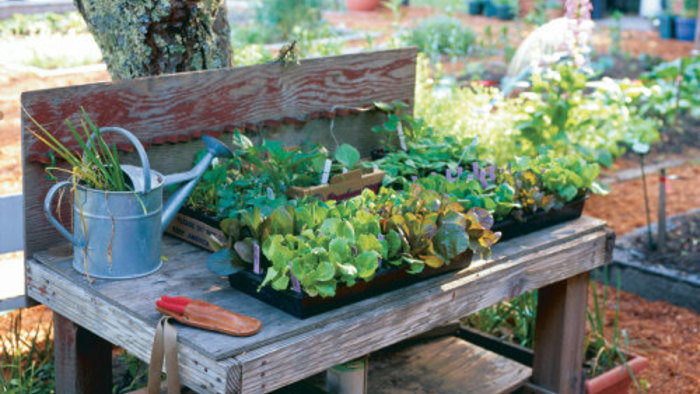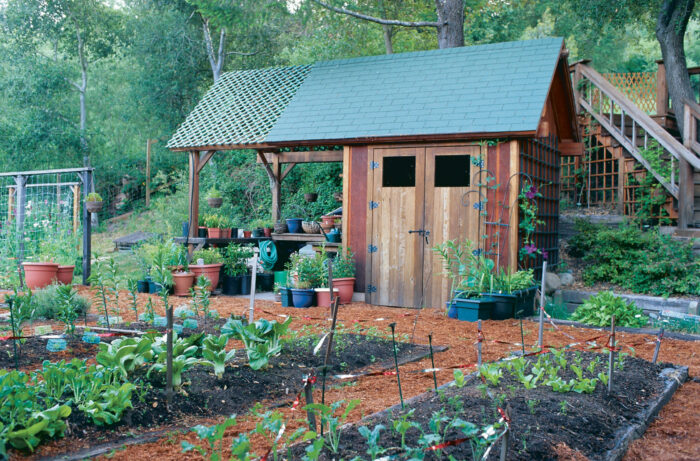How to Grow Heading Lettuce
Crisp and crunchy or buttery and tender, heading varieties of lettuce have lots to offer

Some of the most rewarding crops of the kitchen garden are heading lettuces with their mosaic of colors, textures, and leafy rosette shapes. Unfortunately, many of us have grown up associating head lettuce with rock-hard commercial iceberg and its pale, water-filled leaves. While there are, in fact, some nice home-garden iceberg varieties, a large and very diverse world of other heading lettuces is available to grow from seed. They offer great flavor and beauty, and extend the garden season in both directions.
“Heading” is a general and rather ambiguous term in describing lettuce forms, and can include everything from a tight, semi-solid, heavy vase of crispy romaine to the softly folded, leafy rosettes of tender, succulent butterheads. Leaf textures range from firm and crunchy to melting and buttery on the tongue, and colors are available from pale lime green to deep burgundy bronze. Within this wide array of choices there are three fairly distinct categories of heading lettuces.

The familiar romaines
A perennial favorite for its color and texture is ‘Rouge d’Hiver’. This 150-year-old French heirloom has broad leaves in red hues, tapering to emerald-green at the base. ‘Rouge d’Hiver’ does well in spring, early summer, and fall plantings. Cool weather really brings out the eye-catching color, as it does for all red lettuces. I like to plant ‘Rouge d’Hiver’ with a green variety in simple geometric patterns. Other notable red romaines, all developed from ‘Rouge d’Hiver’, include ‘Rosalita’, ‘Majestic Red’, and ‘Cimmaron’. The romaines’ broadly oblong, upright leaves cluster around thick, juicy, full-flavored hearts. Romaine leaves are sweet and crunchy with lots of substance. They hold up well to heavy dressings and in sandwiches. In Middle Eastern and many Asian cuisines, romaine leaves are used as edible food wrappers or servers. Commercial varieties are bred for large size and weight and supermarket romaines often have huge, tough, leathery leaves. Fortunately, home gardeners have their choice of tender, tasty varieties. Romaines are the best bet for whole-meal salads, where you want leaves with juicy crunch and substance to pair with cubed or sliced cooked meats, vegetables, and cheeses.
There are several outstanding green romaines. ‘Jericho’ forms heavy heads of fine-tasting, sword-shaped, crunchy leaves. The heads are heat tolerant and resistant to tip burn. ‘Olga’, with lighter green leaves and pale buttery heart, is noteworthy for its sweet flavor and uniform growing habit.
If you have a small garden, try the traditional English miniature ‘Little Gem’, also known as ‘Sugar Cos’ or ‘Sucrine’. Each crunchy 4-in.-diameter rosette makes a complete salad. ‘Little Gem’ heads are tightly packed with bright green, slightly wavy leaves. They grow rapidly. I often succession sow them for several harvests throughout spring and fall.
The big, beautiful batavians
Long popular as fresh-market lettuces in Western Europe, especially France, the beautiful and luscious batavians are not yet grown for commercial distribution in the United States. Fortunately, seeds of the best varieties are available to kitchen gardeners. Batavians combine the sweet crispness of romaine with a more open butterhead-like shape. Some are remarkably resistant to bolting. Color and leaf shape differ depending on variety, but all batavians start out in an open, broad-leafed cluster and mature into a compact, dense rosette of colorful, substantial leaves. Use them in salads and sandwiches and as a flavorful, crispy lettuce to shred for tostadas and tacos. Or combine the leaves with grapefruit sections, berries, sweet onions, avocados, or seafood.
‘Nevada’ reliably produces fine quality, handsome, big heads that look like a leafy rose. The crunchy leaves are shiny, medium green with a somewhat savoyed texture. ‘Nevada’ is resistant to tip burn, bottom rot, and bolting.
‘Sierra’ has satiny, wavy leaves of soft green overlaid with red. The broad, crinkled leaves mature in a whorled shape, forming a fairly solid, oval head with tender, blanched hearts. ‘Sierra’ is a fine warm-weather choice. I plant it for spring, summer, and fall harvests.
One of the loveliest batavians is the 1997 introduction ‘Cardinale’. This classically beautiful, big lettuce has an open habit. Its frilled burgundy leaves are rich green at the base and form 12-in.-tall, substantial rosettes that hold up well after harvest.
The tender butterheads
Depending on what part of the country you live in, you may think of the third category as butterhead, Bibb, Boston, or limestone. These lettuces form softly folded, smooth-leafed, lighter green rosettes. In Europe, butterheads are the lettuce of choice, outselling all others.
‘Merveille des Quatre Saisons’ is a classic, both beautiful and delicious. This outstanding lettuce forms firm center rosettes of green surrounded by immense ruby-tipped leaves. Its delightful color and soft texture make it a great kitchen garden variety.
‘Nancy’ is a large, open, green butterhead with thick, succulent leaves and a pale, tightly folded, creamy heart. It’s perfect for delicate salads with toasted nuts, blue cheese, and pears. ‘Nancy’ is disease resistant, and holds well after harvest.
‘Juliet’, my favorite red butterhead, has tender, buttery-tasting leaves with a delicate melting texture. The luxuriant, loosely wrapped green leaves are blushed with burgundy on their edges.
Evenly moist is your mantra
While it is possible to grow good lettuce from seed sown directly into the garden, I get my best results starting seed in flats or containers. This way, I can keep the seeds evenly moist while they are germinating. Once they are up and growing, but still tiny and vulnerable, they remain protected from weather swings, birds, and insects.
Use containers at least 2 in. deep filled with a good soilless seed-starting mix. Sprinkle seeds thinly, about ¼ in. to ½ in. apart, cover lightly, and keep the medium moist. Germination is best at cool temperatures of 60° to 70°F. Once seedlings emerge, continue to keep them evenly moist. After several weeks, when they are a few inches tall, transplant into the garden in finely prepared soil, 4 in. to 6 in. apart. Do a final thinning to 12 in. apart when plants are about 5 in. tall, and enjoy the young succulent seedlings as your first rewards. This final thinning is important, as these lettuces need room to grow to big beautiful heads. Plan a late summer planting because autumn-grown lettuce stands beautifully without bolting or getting bitter.
If a spell of hot weather hits, suspend shade cloth above the bed to protect the plants. Always keep the bed carefully watered. If weather continues very hot, plan on harvesting early.Throughout their tenure in the garden, lettuce plants should be kept moist to encourage regular growth and sweet tasting leaves. Fertilize several times with a half-strength solution of fish emulsion and liquid kelp or seaweed. I keep pesky birds from eating young lettuces by stringing reflective foil tape above the lettuce bed. Row covers also work. Handpicking earwigs, slugs, and snails after dark for several days is usually an effective way to deal with these pests.
Lettuce seed is not a reliable keeper. Store extra seed indoors in a cool, dry place, and sow a little thicker the following season. Discard seeds after two seasons.
Sources
Johnny’s Selected Seeds
955 Benton Avenue
Winslow, ME 04901
877-564-6697
www.johnnyseeds.com
Pinetree Garden Seeds
PO Box 300
New Gloucester, ME 04260
207-926-3400
www.superseeds.com
Renee’s Garden Seeds
6116 Highway 9
Felton, CA 95018
888-880-7228
www.reneesgarden.com
Seeds of Change
PO Box 15700, Santa Fe, NM 87506;
888-762-7333
www.seedsofchange.com
Fine Gardening Recommended Products

Gardener's Log Book from NYBG
Fine Gardening receives a commission for items purchased through links on this site, including Amazon Associates and other affiliate advertising programs.

A.M. Leonard Deluxe Soil Knife & Leather Sheath Combo
Fine Gardening receives a commission for items purchased through links on this site, including Amazon Associates and other affiliate advertising programs.

The New Organic Grower, 3rd Edition: A Master's Manual of Tools and Techniques for the Home and Market Gardener, 30th Anniversary Edition
Fine Gardening receives a commission for items purchased through links on this site, including Amazon Associates and other affiliate advertising programs.










Comments
Log in or create an account to post a comment.
Sign up Log in